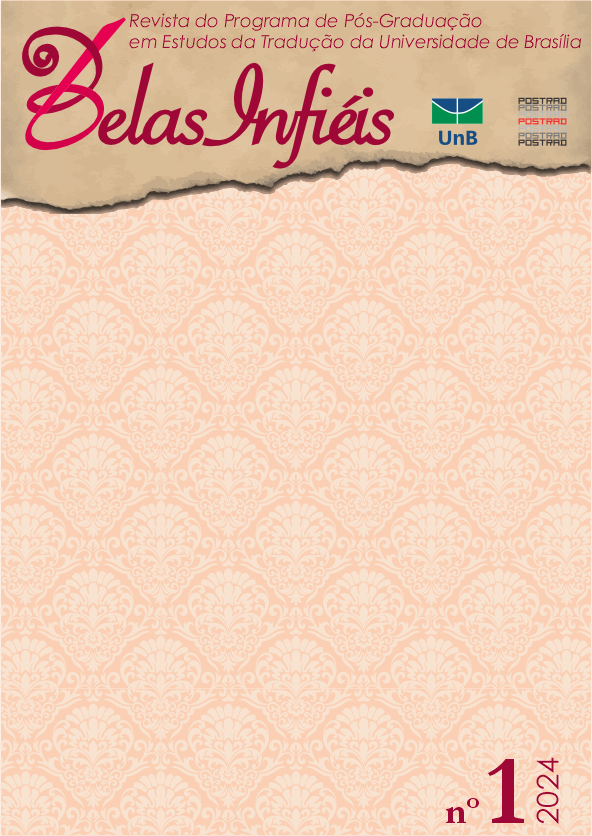Um drácula brasileiro: análise da transposição do gótico na tradução de Lúcio Cardoso
DOI :
https://doi.org/10.26512/belasinfieis.v13.n1.2024.53023Mots-clés :
Tradução. Gótico. Transposição do Gótico. Drácula. Lúcio Cardoso.Résumé
O presente artigo tem como objetivo analisar a tradução Drácula: O Homem da Noite, de Lúcio Cardoso, feita em 1943, em comparação com o texto-fonte publicado por Bram Stoker em 1897. A tradução de Cardoso tem significativa relevância para o campo de Estudos da Tradução, uma vez que foi a primeira a aparecer em língua portuguesa do Brasil e uma das primeiras a tentar realizar a difícil tarefa de transportar os elementos góticos na tradução. O embasamento teórico consiste em teorias do gótico como modo literário, sendo nosso estudo fundamentado por Botting (1996), França (2017), Groom (2012), Hogle (2002) e Spooner (2007). A estratégia para a execução deste trabalho gira em torno da análise comparativa entre o texto-fonte e a tradução de Cardoso, observando como o tradutor trabalha com elementos característicos da ficção gótica e quais supressões de trechos originais são encontradas (ou não) em sua tradução. Os resultados obtidos apontam que a tradução de Cardoso é significativamente diferente do texto-fonte, a ponto de não ser possível encontrar, em determinados momentos, correspondências entre os textos em aspectos que caracterizam a obra de Stoker como gótica, segundo colocações de Hogle (2002).
Téléchargements
Références
Aran, P. (2022). Gótico - gênero literário. In J. França, C. Reis, D. Roas, F. Furtado, & F. García (Eds.), Dicionário Digital do Insólito Ficcional (e-DDIF). 2. ed. Dialogarts. Disponível em: https://www.insolitoficcional.uerj.br/gotico-genero-literario/. Acesso em: 3 de março de 2023.
Barros, F. M. de. (2008). O Gótico e a Brasilidade em Lúcio Cardoso. Revista do Centro de Estudos Portugueses, 28(39), 113-131.
Bellas, J. P. (2020). Gótico Brasileiro: uma proposta de definição. Organon, 35(69), 1-15.
Botting, F. (1996). Gothic. Routledge.
Cardoso, L. (1943). Sou um Homem ou um Monstro? Revista Leitura, 4(1), 23 e 35. Disponível em: https://memoria.bn.gov.br/DocReader/docreader.aspx?bib=115509&pasta=ano%20194&pesq=&pagfis=2053 Acesso em: 07 ago. 2024.
Cohen, J. J. (ed.). (1996). Monster Theory. Reading Culture. University of Minnesota Press.
Dowling, L. (1979, 1 mar.). The Decadent and the New Woman in the 1890's. Nineteenth-Century Fiction, [S.L.], 33(4), 434-453. University of California Press. http://dx.doi.org/10.2307/2933251. Disponível em: https://www.jstor.org/stable/2933251?seq=1 Acesso em: 05 mar. 2023.
França, J. (2017). O sequestro do Gótico no Brasil. In L. Colucci, & J. França, As nuances do Gótico: do Setecentos à atualidade. Bonecker.
Groom, N. (2012). The Gothic: A Very Short Introduction. Oxford University Press.
Hogle, J. E. (2002). Introduction: The Gothic in Western Culture. In J. E. Hogle (Ed.), The Cambridge Companion to Gothic Fiction (pp. 1-20). Cambridge University Press.
Miles, R. (2002). The 1790s: the effulgence of Gothic. In J. E. Hogle (Ed.), The Cambridge Companion to Gothic Fiction (pp. 41-62). Cambridge University Press.
Resende, A. (2021). O Drácula de Lúcio Cardoso. Scripta Uniandrade, 19(3), 331-347.
Sá, D. S. de. (2010). Gótico Tropical: O Sublime e o Demoníaco em O Guarani [Dissertação de mestrado, EDUFBA].
Spooner, C. (2007). The Gothic in the Twentieth Century. In C. Spooner, & E. McEvoy (Eds.), The Routledge Companion to Gothic. Routledge.
Stoker, B. (2003). Dracula (2. ed.). Penguin Books.
Stoker, B. (2013). Drácula: O Homem da Noite. (L. Cardoso, trad.). Civilização Brasileira.
Stoker, B. (2018). Drácula. (M. Heloisa, trad.). Darkside.
Téléchargements
Publié-e
Comment citer
Numéro
Rubrique
Licence
(c) Tous droits réservés CC BY 2024

Cette œuvre est sous licence Creative Commons Attribution 4.0 International.
Copyright Statement
Given the public access to this journal, the texts are free to use but requires the recognition of the original authorship and initial publication in this journal to be properly stated.
The journal allows the use of works published for non-commercial purposes, including the right to submit the work to publicly accessible databases. Published contributions are the sole and exclusive responsibility of the author(s).
- When submitting papers to be evaluated by the Belas Infiéis journal, the author(s):
- Declare that the contents of the contributions are original and of their original creation, being entirely responsible for their content if there is an objection by third parties.
- Claim to be aware that they should not commit academic plagiarism.
- Declare that the manuscript has not been published, completely or partially, in Portuguese or another language. If it is a translation it should be submitted to the Translated Articles section.
- Declare that the manuscript is not being evaluated by other journals.
- Declare that the manuscript was not submitted to another journal simultaneously.
- Commit(s) to inform the journal of any kind of error or inaccuracy in their contribution (published, in evaluation or in editing) and to collaborate with the editors to make due corrections of the article (when in evaluation or editing) or erratum/retraction (after publication).
- Declare that there is no conflict of interest regarding the published work.
- Authorize its release if it is accepted for publication without any kind of monetary compensation.
- Agree to assign non-exclusive rights to publication to the magazine, remaining free to make their contribution available in other media as long as the publication of the first version in Belas Infiéis magazine is mentioned. They also authorize Belas Infiéis to assign their texts for reproduction in content indexers, virtual libraries and similar platforms.
- Maintain copyright and grant the journal the right of first publication, the work being licensed under theCreative Commons Attribution License.
- Is/Are allowed and encouraged to publish and distribute their work online after the editorial process, which may increase the impact and citation of the published work.
- Authorize the editorial team to make textual adjustments and to adapt the article to the publication rules, when necessary.



















